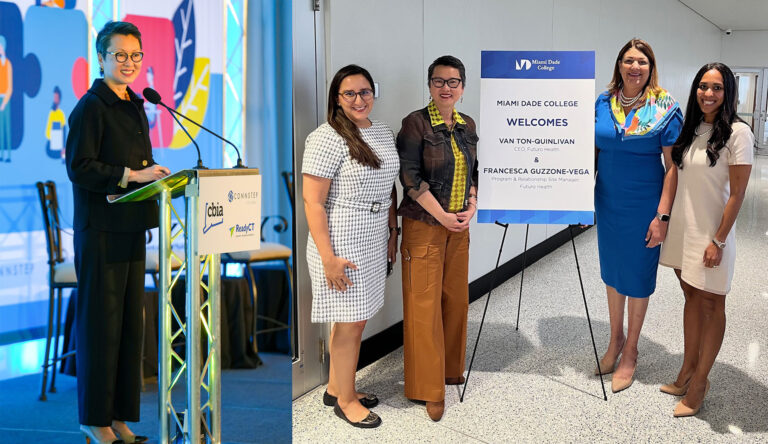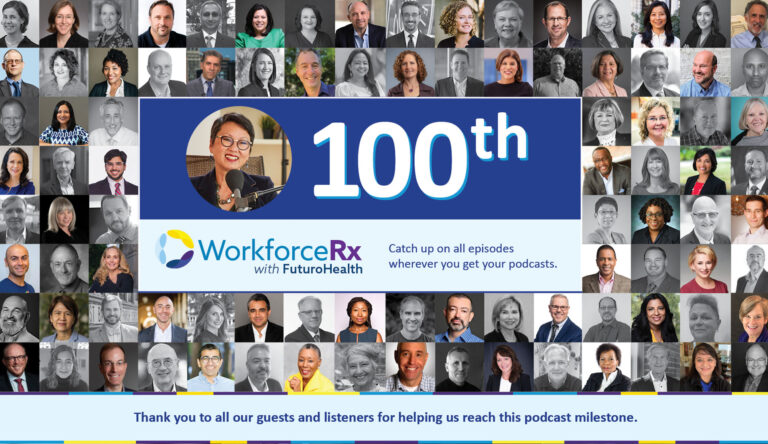The labor market in the United States is experiencing a time of crisis. Though the picture was not rosy before the pandemic, COVID-19 has only made it worse. Everyone seems to be seeking work or looking for workers. But too few are finding what they’re looking for.
The problem isn’t a lack of talent or opportunities for employment. So, where’s the disconnect?
According to Van Ton-Quinlivan, CEO of Futuro Health and author of the new book “WorkforceRx: Agile and Inclusive Strategies for Employers, Educators, and Workers in Unsettled Times”, it’s about “connecting people with the right skills for the right jobs.”
Her book lays out a series of workforce development strategies that employers can use to target the talent pools they need and work collaboratively to leverage best practices.
Futuro Health recently convened a live panel discussion for the book’s launch with some of Van’s friends and colleagues in the field of workforce development. They discuss their insights from chapters seven and eight, which examine “Leveling the Slope of Unconscious Bias” and “Making Education Upgrades the New Norm.”
The group discusses the importance of “master catalysts” for systemic change, the usefulness of microcredentialing as an inclusive and responsive strategy, and how a shift away from a degree-centric approach can capture sidelined talent.
The Panelists
Holly Zanville, Co-Director of Program on Skills, Credentials and Workforce Policy, GW Institute of Public Policy at The George Washington University
John Brauer, Executive Director for Workforce and Economic Development, California Labor Federation
Shannon Lucas, Co-CEO, Catalyst Constellations
Tracey Lovejoy, Co-CEO, Catalyst Constellations
Paul Granillo, President and CEO, Inland Empire Economic Partnership
Linda Wah, Trustee, Pasadena City College
Gustavo Herrera, CEO, Arts for LA

'Master catalysts' drive systemic change
As co-founder of a company focused on training and coaching people to be catalysts, Shannon thinks tackling big problems like the workforce crisis requires systemic change. For that, we need “master catalysts” like Van.
Shannon describes Van’s strategy as finding and creating “shared value” — which is a “next-level skill for change agents.” She notes that Van approaches everything from a systems perspective.
Shannon says Van transformed a “highly competitive and dysfunctional” statewide ecosystem of community colleges into a “highly networked and collaborative” system that proved to be more efficient and beneficial to those it serves. “It’s about systems change,” Shannon explains. “It’s not about going in on one small problem, because if you don’t unpack the whole system … you’re not going to get to that shared value.”

Systems thinking overcomes unconscious bias
Shannon’s business partner Tracey agrees, going on to highlight that sustainable, meaningful change starts with being able to identify the real problems.
That requires scientific inquiry, looking at systems as networks of multiple actors, and really listening instead of just talking. Tracey points out that most people take a local or organizational approach to workforce development, as doing it systematically can feel “impossible.” But Van’s book helped her place workforce development within a broader context.
She cites the example of unconscious bias in community colleges. Van has shown that while most people think bias stems from a “lack of dollars,” the bigger problem is often a “lack of people to go after the dollars” and leveraging funds to create change.
By creating collaborative networks, Van “created a pathway to tie schools together,” which helps them see the world from diverse perspectives. Shannon thinks this approach can help us all become better problem solvers.

Shifting to skills-based criteria to capture sidelined talent
Linda also talks about unconscious bias, specifically how it resonates with her efforts to promote diversity and inclusion in California’s Community College system. She points out that this not only impacts the system’s hiring practices but what students encounter in the workforce.
Van’s book describes how traditional degree-based hiring criteria end up sidelining valuable talent. Linda explains it like this: “Sixty percent of Americans who are over the age of 25 don’t have bachelor’s degrees. So, if bachelor’s degrees become the criteria by which you’re going to hire people, we are leaving out 60% of our population.”
The specific people who often get bypassed are what Linda calls STARS, or Skilled Through Alternative Resources. STARS gain their skills through alternative sources like the military and on-the-job training. Microcredentialing and microbadging can go a long way toward bringing them into the workforce.

Credential-as-you-go is a flexible and inclusive strategy
As the co-leader of a national initiative to “transform the antiquated U.S. degree-centric system” into one that rewards individual skills, Holly also applauds the credential-as-you-go approach detailed in “WorkforceRx.”
She points out that half of all college-enrolled Americans, around 38 million people, end up dropping out, joining what she calls the “no-credentials club.”
She asks: “Are we really to conclude that these millions of students did not learn anything valuable enough to be credentialed because they did not complete their degrees?”
Holly works with state-level agencies to develop ways to integrate incremental credentials — like short-term certificates, digital badges, and industry certifications — into traditional educational systems. She thinks these are “part of the agile and inclusive strategies that employers, educators, and workers need in unsettled times.”

Microcredentialing makes existing systems more responsive
Microcredentialing also resonated with John, who is helping to address a shortage of 600,000 home healthcare workers in the state of California.
He points out that many of these workers are immigrants and other English language learners, and that microcredentialing has a “big future” in conjunction with existing workforce systems. Skills-based systems are also more adaptive and responsive, he says.
His organization is considering Van’s ideas in its work to credential California healthcare workers and train them to use various technologies. These initiatives also lead to better healthcare outcomes for everyone.
Van notes that this problem is endemic at the national level as well, so any lessons learned in California can certainly be shared and exported elsewhere.

Measure what counts to keep up with the rate of change
Van emphasizes that systemic change “is not something that you can do top-down, because there’s not one thing [to improve] in every region.”
Paul, who describes himself as a “regional guy,” can certainly appreciate this.
His experience is focused on California, which he calls an “economy of regions where each region is unique.” The state has some of the lowest baccalaureate attainment rates in the country. Yet the jobs that drive the economy in his area are centered around healthcare, manufacturing, and the supply chain.
“The need for a workforce that is prepared now is absolutely incredible,” he says.
But in order to stay ahead of the curve, we need to be able to keep up with the rate of change.
This involves working with both industry and education partners to ensure that the population is “constantly studying and learning” and “measuring what counts,” he adds.
It’s not just about closing the gap but improving the quality of life for today’s workers and generations to come.

Developing human skills builds real leaders
As CEO of an arts advocacy organization, Gustavo appreciates how Van’s book not only addresses how to build a stronger workforce but how to “build a more creative workforce” that can help us all thrive.
Gustavo believes that to develop strong leadership over time, we need people trained in what is often known as “soft skills,” which he prefers to call “human skills.” These include “compassion, empathy, ethics, collaboration, and creativity.”
Van’s book has been a valuable playbook for him, as it offers “real-world, real-time problem-solving that will help leaders trying to drive seismic change.”
This article is based on a special episode of the Workforce Rx with Futuro Health podcast. Episodes feature leaders and innovators sharing insights into the future of work, care, higher education, and alternative education-to-work models. Be sure to subscribe via Apple, Spotify, or wherever you get your podcasts.



